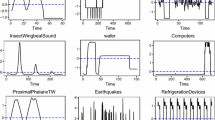Abstract
Dynamic time warping (DTW) is a state-of-the-art time series similarity measure method, which warps time axes to match the same shape between two time series with different lengths. However, its quadratic time and space complexity is an obstacle to its applications in the large time series data mining. To address this problem, some lower-bound functions for DTW, fast methods to approximately measure the distance between time series, are used to prune the dissimilar objects from time series database so as to retain the candidates for further measuring their similarity with DTW. So far, the existing lower-bound functions for DTW have been widely accepted for time series similarity search and indexing. In this paper, we propose the extensions of two existing lower-bound functions and discuss the relationships among them. The extensions are improved with high tightness and without much time cost. At the same time, we theoretically prove that these extensions satisfy lower-bound requirement and are better than their old versions respectively. The experimental results demonstrate that in most cases the quality of the proposed extensions of lower-bound functions for DTW outperforms the original versions except for a slightly higher time cost.
















Similar content being viewed by others
References
An, J., Chen, Y.P.P., Chen, H. (2005). DDR: an index method for large time-series datasets. Information Systems, 30(5), 333348.
Boucheham, B. (2010). Reduced data similarity-based matching for time series patterns alignment. Pattern Recognition Letters, 31(7), 629638.
Fu, T.C. (2011). A review on time series data mining. Engineering Applications of Artificial Intelligence, 24(1), 164181.s.
Gullo, F., Ponti, G., Tagarelli, A., Greco, S. (2009). A time series representation model for accurate and fast similarity detection. Pattern Recognition, 42(11), 29983014.
Jeong, Y.S., Jeong, M.K., Omitaomu, O.A. (2011). Weighted dynamic time warping for time series classification. Pattern Recognition, 44(9), 22312240.
Keogh, E. (2005). Exact indexing of dynamic time warping. In Proceedings of the 28th international conference on very large data bases, (pp. 358380).
Keogh, E. (2011). Welcome to the LB Keogh homepage. http://www.cs.ucr.edu/~eamonn/LB_Keogh.htm.
Keogh, E., & Pazzani, M.J. (2001). Derivative dynamic time warping. In Proceedings of the first SIAM international conference on data mining, (pp. 111).
Keogh, E., Xi, X., Li, W., et al. (2011). Welcome to the UCR time series classification/clustering page. http://www.cs.ucr.edu/eamonn/time_series_data/.
Kim, S.W., Park, S.H., Chu, W.W. (2001). An index-based approach for similarity search supporting time warping in large sequence databases. In Proceedings of the 17th international conference on data engineering, (pp. 607614).
Kim, S.W., Yoon, J.H., Park, S.H., Kim, T.H. (2002). Shape-based retrieval of similar subsequences in time-series databases. In Proceedings of the 2002 ACM symposium on applied computing, (pp. 438445).
Kremer, H., Günnemann, S., Ivanescu, A., Assent, I., Seidl, T. (2011). Efficient processing of multiple DTW queries in time series databases. In Proceeding of the 23nd international conference on scientific and statistical database management, (pp. 150167).
Li, H., Guo, C., Yang, L. (2011). Similarity measure based on piecewise linear approximation and derivative dynamic time warping for time series mining. Expert Systems with Applications, 38(12), 1473214743.
Liao, TW (2005) Clustering of time series data—a survey. Pattern Recognition38(11): 1857–1874.
Mu, B., & Yan, J. (2009). An adaptive filter technique for time series search. In Proceedings of the 2rd international conference on business intelligence and financial engineering, (pp. 283287).
Park, S.H., Kim, S.W., Chu, W.W. (2001). Segment-based approach for subsequence searches in sequence databases. In Proceedings of the 2001 ACM symposium on applied computing, (pp. 248252).
Rakthanmanon, T., Campana, B., Mueen, A., et al. (2012). Searching and mining trillions of time series subsequences under dynamic time warping. In Proceedings of the 18th ACM SIGKDD conference on knowledge discovery and data mining, (pp. 262270).
Ratanamahatana, C.A., & Keogh, E. (2004). Everything you know about dynamic time warping is wrong. SIGKDD workshop on mining temporal and sequential data.
Sakoe, H., & Chiba, S. (1978). Dynamic programming algorithm optimization for spoken word recognition. IEEE Transactions on Acoustics, Speech and Signal Processing, 26(1), 4349.
Sakurai, Y., Yoshikawa, M., Faloutsos, C. (2005). FTW: fast similarity search under the time warping distance. In Proceedings of the 2005 principles of database systems, (pp. 326337).
Salvador, S., & Chan, P. (2007). FastDTW: toward accurate dynamic time warping in linear time and space. Intelligent Data Analysis, 11(5), 561580.
Tang, H., & Liao, S.S. (2008). Discovering original motifs with different lengths from time series. Knowledge-Based Systems,21(7), 666671.
Wang, Q., & Megalooikonomou, V. (2008). A dimensionality reduction technique for efficient time series similarity analysis. Information Systems, 33(1), 115132.
Wang, Q., Megalooikonomou, V., Faloutsos, C. (2010). Time series analysis with multiple resolutions. Information Systems, 35(1), 5674.
Yi, B.K., & Faloutsos, C. (2000). Fast time sequences indexing for arbitray L p norms. In Proceedings of the 26th international conference on very large data bases, (pp. 385–394).
Yi, B.K., Jagadish H. V., Faloutsos C. (1998) Efficient retrieval of similar time sequences under time warping. In Proceedings of the 14th international conference on data engineering, (pp. 201–208).
Zhang, X., Liu, J., Du, Y., Lv, T. (2011). A novel clustering method on time series data. Expert Systems with Applications, 38(9), 1189111900.
Acknowledgments
This work has been partly supported by the National Natural Science Foundation of China (61300139) and the Society and Science Planning Projects in Fujian (2013C018). We also would like to acknowledge Prof. Eamonn Keogh for the datasets.
Author information
Authors and Affiliations
Corresponding author
Rights and permissions
About this article
Cite this article
Li, H., Yang, L. Extensions and relationships of some existing lower-bound functions for dynamic time warping. J Intell Inf Syst 43, 59–79 (2014). https://doi.org/10.1007/s10844-014-0306-7
Received:
Revised:
Accepted:
Published:
Issue Date:
DOI: https://doi.org/10.1007/s10844-014-0306-7




